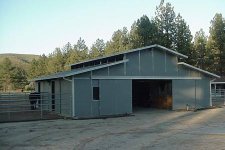RichT
Silver Member
Planning a DIY 36'x24' pad for a steel barn (SOCAL area). Std 4in pad with 2-4in gravel underlayment, 12"x12" footing. If my calcs are right, about 15.5 yds of concrete. I've done a moderate amount of concrete work, but never anything this size. Monolithic pour, good access to pad area, shouldn't need pumper. Probably 2 truck loads.
For 4in slabs, most seem to recommend 1" deep joints on 10' spacing. My plan is to create 6 12' squares with joints at 12' and 24' on the long side and 12' on the short side. Methods I've seen for joints: hand tool, saw cut, and hard board inserts. Suggestions?
Finishing. This is the part I'm most worried about as I've never finished anything this size. My plan: bull float, edge it, tool or hard board the joints, wait for bleed water to evaporate, wood float (using plywood platform to get to interior area), broom finish. Suggestions?
Do you think this is too big for a DIY project? I can excavate with my Kubota BX22 and have plenty of wood for forms. If you think its feasible for a DIY project, how many of my friends should I deputize to help?
For 4in slabs, most seem to recommend 1" deep joints on 10' spacing. My plan is to create 6 12' squares with joints at 12' and 24' on the long side and 12' on the short side. Methods I've seen for joints: hand tool, saw cut, and hard board inserts. Suggestions?
Finishing. This is the part I'm most worried about as I've never finished anything this size. My plan: bull float, edge it, tool or hard board the joints, wait for bleed water to evaporate, wood float (using plywood platform to get to interior area), broom finish. Suggestions?
Do you think this is too big for a DIY project? I can excavate with my Kubota BX22 and have plenty of wood for forms. If you think its feasible for a DIY project, how many of my friends should I deputize to help?
